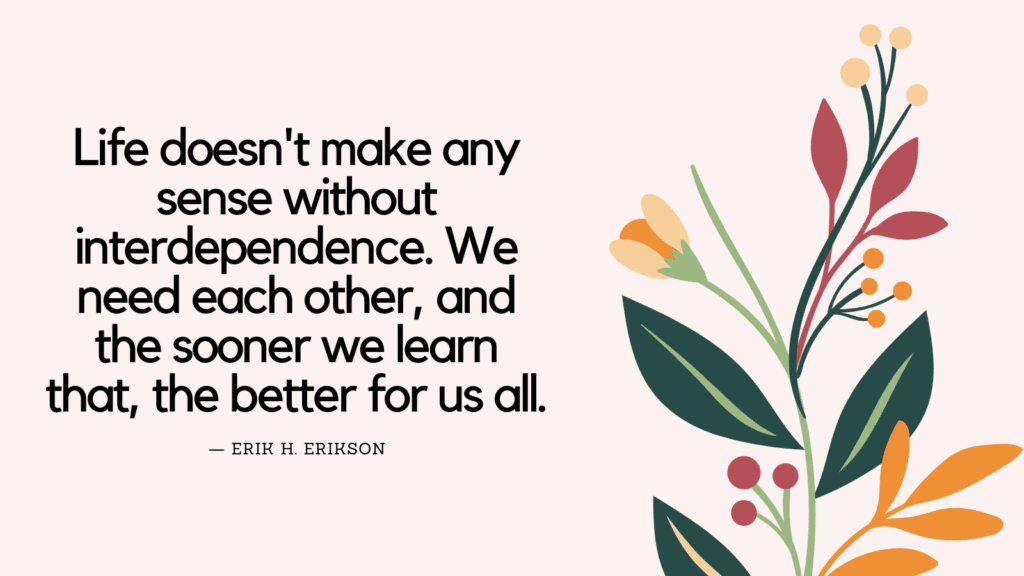This post contains some of the best trauma bonding quotes.
What Is Trauma Bonding?
Trauma bonding is a complex psychological condition that can occur in an abusive or emotionally manipulative relationship.
It refers to a strong emotional attachment and loyalty a victim may feel towards their abuser despite the abuse and mistreatment they endure.
This bond often develops as a result of intermittent reinforcement, where the abuser alternates between being kind and loving and being hurtful and abusive. The victim may begin to associate the abuser’s rare moments of kindness with the belief that the abuser truly cares for them.
The victim also may become dependent on the abuser due to isolation, fear, financial control and other forms of manipulation. This dependency can make it difficult for the victim to leave the abusive relationship even when they are aware of the harm it is causing them.
Related: Best 5 Stockholm Syndrome & Trauma Bonding Books
Trauma Bonding Quotes
1. “Confusing genuine love and the trauma bond is incredibly easy to do. Lines get blurred beyond comprehension, particularly when you’re in a foggy state of mind due to being treated so despicably.” – Laura Kozlowski
2. “You may have already left your abuser, but are still struggling with the trauma bond. The invisible cord that ties you to them isn’t so easily cut, and simply leaving the relationship isn’t always enough to snip that malignant thread that’s tethered to you.” – Laura Kozlowski
3. “Oftentimes when I’m talking to other victims of narcissistic abuse and the subsequent trauma bond, I hear about the survivor experiencing mixed feelings for their partner, who behaves so abusively. I can absolutely resonate with this – it’s like a mental game of tug of war.” – Laura Kozlowski
4. “When abuse is perpetrated by intimates, it is additionally confounding in terms of attachment, betrayal, and trust. Victims may be unable to leave or to fight back due to strong, albeit insecure and disorganized, attachment and misplaced loyalty to abusers. They may have also experienced trauma bonding over the course of their victimization, that is, a bond of specialness with or dependence on the abuser.” ― Christine A. Courtois
5. “The abuser completely has your heart in their grasp, but it appears there’s always a little shred of logic and rationale that they didn’t manage to capture. It’s this glimmer of reason that tries to fight against the bond and creates an internal war of heart versus head. Of course, we both know which one wins most of the time.” – Laura Kozlowski
6. “Some victims endure it almost every day – they’ll wake up with a sick feeling in the pit of their stomach, unsure as to how the day will pan out. Will they be abused today? Will they be screamed at, told they’re pathetic, will they be berated for not doing something to their abuser’s liking? Others may endure this toxic behavior much less, but when it happens, it completely throws their entire being off-kilter. Either way, a toxic trauma bond can be formed, and regardless of the frequency of abuse, it’s just as hard to handle.” – Laura Kozlowski
7. “Hopefully, this stripped-down science lesson can help you see how trauma bonds occur – when the person who we regard as our significant other, or the ‘caregiver,’ is also the one creating our trauma by threatening our safety through their abusive behavior towards us. We are all essentially wired from the minute we are born to turn towards an attachment figure, particularly when we feel under threat. This need for protection doesn’t go away as we get older, but the person we turn to for security changes.” – Laura Kozlowski
Related: Top 10 Signs Of Trauma Bonding & How To Heal A Trauma Bond
8. “You also don’t enter the relationship and suddenly become ‘trauma bonded’. Like anything with the narcissist, it’s carefully planned and executed, and there is a process to you becoming toxically bonded and emotionally dependent on your abuser.” – Laura Kozlowski
9. “Trauma bonding and Stockholm Syndrome have a lot of similarities, and the symptoms and methods used by the abuser often run parallel to that of trauma bonding.” – Laura Kozlowski
10. “Despite years of research about the horribly damaging effects of trauma and abuse and the fact that victims will often go back to their abusers many times before they finally leave for good, society still doesn’t seem to understand the powerfully shattering effects of trauma bonding can cause. It takes a victim an average of 7 times before they leave their abuser for good, but I can admit (as well as many other people whom I’ve spoken to can attest to this), I feel the true statistic for this is much higher.” – Laura Kozlowski
11. “Trauma bonding is usually exceptionally fierce in situations where there are repetitive cycles of abuse. This often results in the victim having a desire to rescue their abuser, to free them from the thing inside them that causes them to behave so toxically. This desperate want to help change their abuser for the better is often present in the victim, no matter how much they’ve been betrayed by their abuser. However, during this need to repair a broken narcissist or make them ‘better’, the victim is likely going through cognitive dissonance.” – Laura Kozlowski
Related: 7 Stages Of Trauma Bonding (+FREE Worksheets)
12. “Cognitive dissonance can manifest itself in a way that allows the victim of this situation to convince themselves that the relationship is still in the idealization stage when, in reality, it has moved into the stage of devaluation. It can also allow the victim to push the blame for the injustices in the relationship away from their abuser (due to fear of reprisal) to either themselves or another victim. It also helps in hiding the shame of being in such a dysfunctional relationship. This inner dialogue then reduces the anxiety felt by the victim, further enabling a trauma bond to develop.” – Laura Kozlowski
13. “We’ve established that trauma bonds are addictive. They produce brain chemicals that are hard to overcome. When people get involved in relationships that are toxic, they become hooked on the good experiences their spouse can bring into their lives. Breaking that addiction is essentially overcoming the undeniably strong brain chemistry created by powerful and emotional experiences. It’s hard to do when it feels like your mind is working against all logic and reason.” – Laura Kozlowski
14. “Trauma bonds are stronger than typical human bonds – think of a trauma bond as the giant Goliath of a bond. Where a person ends a relationship that was bonded without the added complexity of trauma, the pain of the breakup is much less intense and painful than it is for those who are traumatically bonded.” – Laura Kozlowski
Related: How To Overcome High Functioning Codependency?
15. “It’s important for you to commit to yourself to live in the truth. Addictive relationships where a trauma bond has developed are just fantasies. I want to remind you that you are in love with what you wish the other person was – you’re not in love with who your partner is. You’re in love with an idea, a memory, a fantasy; it’s not real.” – Laura Kozlowski
16. “Life can be unbelievably good. So can people. It may seem so far away, but genuinely feeling good is within your reach, but you can’t grasp the happiness you deserve while you’re in the constant toxic loop of the trauma bond.” – Laura Kozlowski
17. “The power of the trauma bond is unlike any other connection you’ll feel towards another person in your entire life. It’s an all-consuming, utterly engulfing pit of emotional purgatory.” – Laura Kozlowski
18. “The reality is those who’ve never had the first-hand experience of a trauma bond tend to find it difficult to fully wrap their head around the complexities, inconsistencies, and illogicalness of it all. For people like you and me, however, the reality of a trauma bond is ever prevalent, and we know more than anybody just how entirely crippling it is. We know it’s not black and white.” – Laura Kozlowski
Related: Caregiving vs Caretaking (The Savior Complex)
19. “Shame and reenactment simply intensify the mind-altering experience of trauma. They become allies of one another. They form a devastating combination when they are part of a trauma bond in which there has been betrayal.” – Patrick J. Carnes
20. “In the case of trauma bonds, the relationship itself is mood altering and compelling. This is not about the sadness you would feel over the loss of someone for whom you care. This is about a supercharged relationship that is so compelling it can kill you.” – Patrick J. Carnes
21. “Trauma bonding for children appears to be more severe. First, they are experiencing their primary attachments. If they experience terror in those relationships, the mind creates deep patterns and scripts. Relationships with primary caregivers create a relationship template that will be used across a lifetime.” – Patrick J. Carnes
Related: Are You A Narcissist Enabler? (+Top 5 Tips On How to Avoid Becoming The Narcissist’s Enabler)
22. “Parallels do exist between trauma bonding and codependency because to live with an active addict is often traumatic. For the most part, the addiction field has not incorporated all the trauma research that documents how people grow closer to their abusers in the face of trauma. Yet it is clear that many codependents are also trauma-bonded.” – Patrick J. Carnes
23. “Sometimes those in trauma bonds hold on to the anger as a way to stay connected to the abuser. This anger stems from blame and rage and prevents the survivor from experiencing her pain.” – Patrick J. Carnes
24. “Trauma bonds can be disrupted when healthy bonds are available.” – Patrick J. Carnes
25. “For trauma bonds to be disrupted, the survivor must be able to identify the cycles of abuse and the roles of victim, victimizer and rescuer. This is how the relationship system and the roles of the survivor in that system can change.” – Patrick J. Carnes
Related: Codependency Quiz (+FREE Codependency Worksheets PDF)

How to Break Free From Trauma Bonding?
1. Educate yourself: Learn about trauma bonding and its effects. Understanding the psychological dynamics at play can help you gain clarity and perspective.
2. Seek support: Reach out to trusted friends, family members, or support groups who can offer emotional support and validation during this process. It can be helpful to share your experiences with others who have been through similar situations.
3. Establish boundaries: Recognize the importance of setting clear boundaries to protect yourself from further harm. Practice asserting your needs and communicate them assertively to the person with whom you have the trauma bond.
Related: Top 25 Tips On How To Set Boundaries In A Toxic Relationship? (+FREE Worksheets PDF)
4. Practice self-care: Engage in activities that promote self-care and nurture your well-being. This could include regular exercise, meditating, spending time in nature, or pursuing hobbies that bring you joy.
5. Develop a safety plan: In cases where you need to physically distance yourself from the person causing the trauma bond, consider creating a safety plan. This may involve finding a safe place to stay, informing trusted individuals about your situation, and seeking legal advice if necessary.
6. Consider therapy: Consult with a licensed therapist experienced in trauma and abuse recovery. They can help you navigate the healing process, identify underlying issues, and provide appropriate therapeutic interventions tailored to your specific needs.
Related: Breaking Trauma Bond With A Narcissist

Conclusion
Trauma bonding refers to a strong emotional attachment that forms between individuals involved in an abusive or traumatic relationship.
Breaking free from trauma bonding can be a challenging and complex process.
Be patient with yourself and seek professional assistance when needed.



